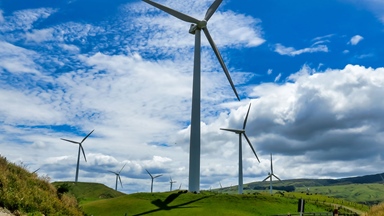At a glance
By Nick Stride
Finance Minister Grant Robertson’s fifth Budget, announced yesterday, sought to balance long-term strategic spending against a near-term need to cushion New Zealand families against rapidly rising living costs.
With inflation at a 30-year high of 6.9 per cent, interest rates rising, COVID-disrupted supply chains and businesses struggling with absenteeism and skills shortages, some commentators see the economy as “red-lining” and at risk of a hard landing.
Robertson says his government’s health and economic responses to “the 1-in-100 year shock” from COVID-19 had delivered “one of the strongest economies in the world,” but noted the whole world would face a volatile and uncertain environment for some time.
Robertson gave himself a NZNZ$5.9 billion operating allowance over the next four years, with new “fiscal rules” allowing plenty of room to increase spending next year ahead of the general election.
A fresh set of Treasury numbers predicts tax revenues of NZ$103.8 billion this year, rising to NZ$116.1 billion in fiscal 2023, NZ$122.7 billion in 2024, and NZ$129.9 billion in 2025.
The government is expected to spend NZ$128.4 billion this year, NZ$127.1 billion next, and NZ$131.1 billion in 2024.
Those deficits are expected to turn to OBEGAL (operating balance before gains and losses) surpluses of NZ$2.6 billion in 2025 and NZ$7.0 billion in 2026.
Room for more debt

Net government debt is forecast to peak at NZ$83.6 billion, or 19.9 per cent of GDP, in 2024, before falling back to 15 per cent in 2026.
Robertson pointed out the latest IMF projection for New Zealand’s peak net debt was half of Australia’s, a third of the UK’s, and a fifth of the US’.
“We are among only a handful of countries with a triple A credit rating from the two leading rating agencies.”
Opposition parties have sought to capitalise on the pain from rising prices, and Robertson threw a one-off $1 billion New Zealanders' way while noting that putting cash in people’s pockets would only fuel inflation further.
An NZ$814 million “cost of living payment” will provide NZ$27 a week for three months to all those who earned less than NZ$70,000 last tax year, provided they are not receiving the Winter Energy Payment.
A further NZ$365 million goes towards extending for two months half-price public transport fares and temporarily reduced fuel excise duties and road user charges.
The government intends to pass legislation urgently to remove “land bank” barriers to new retailers entering the grocery market, as recommended by the Commerce Commission, with NZ$11 million committed as funding.
Robertson noted Treasury expected the “inflation spike” to peak around now, before falling back inside the Reserve Bank’s target band in 2025.
Rick Jones, CPA Australia’s New Zealand Country Head, calls the Budget “cautious” in the face of global uncertainty, but says smaller businesses would be disappointed there was little specific support for them in difficult times.
Centralising health

As promised, the Budget’s biggest-ticket item was health, which will absorb NZ$12.8 billion over four years as the government replaces 20 District Health Boards with the centralised Health NZ and Maori Health Authority.
Over four years, NZ$11.1 billion is allocated to be spent on “a more streamlined and less bureaucratic” system, and a further NZ$1.3 billion on infrastructure and facilities, including hospital upgrades.
Pharmac, the agency that decides which medicines and pharmaceutical products are funded, receives a NZ$191 million boost.
Slim pickings for business

Small Business Minister Stuart Nash unveiled a Business Growth Fund, with NZ$100 million earmarked for a minority government shareholding alongside private banks, to provide growth capital for small businesses.
CPA Australia’s Jones said practitioners and business owners would have mixed reactions.
“Small businesses are generally undercapitalised, so in that sense this is welcome,” he says.
“But there will be some trepidation, because business owners are unlikely to want government- or bank-appointed members sitting on their boards.”
The Regional Strategic Partnership Fund gets the NZ$110 million balance owing on a NZ$200 million commitment, and NZ$54.2 million is committed to tourism sector recovery.
The eight Industry Transformation Plans get NZ$148 million in new operating funding over four years, and NZ$316 million is allocated to the Apprenticeship Boost Initiative, Mana in Mahi, and the Maori Trades and Training Fund.
Under the Digital Technologies Industry Transformation Plan, two initiatives - The New Zealand Tech Story and the Saas Academy - split NZ$20 million over four years.
Jones says the budget is a disappointment for those hoping for strong measures to address a relative lack of digital capability among small businesses, highlighted as a key concern in CPA Australia’s recent Small Business Survey.
“There’s nothing in this budget on tertiary education or stopping the ‘talent crisis’ caused by highly-skilled people going overseas and still-restricted immigration.”
Curbing greenhouse emissions

Sitting outside budget funding from general taxation and new debt is the NZ$4.5 billion Climate Emergency Response Fund, which is to be bankrolled entirely out of Emissions Trading Scheme receipts.
Pre-budget announcements committed NZ$2.9 billion of this to the Emissions Reduction Plan, with allocations to individual initiatives starting modestly but ramping up in the later years of the forecast period.
Transport gets NZ$1.3 billion, including NZ$569 million to help lower- and middle-income families to trade in their petrol-burning vehicles for electric vehicles (EVs), and NZ$350 million to promote walking, cycling and public transport as alternatives to driving cars.
The energy and industry sectors get NZ$764 million, including NZ$653 million for the Government Investment in Decarbonising Industry (GIDI) fund. The rest is allocated to support for businesses to shift to cleaner energy and funding for upgrading of the national grid and electricity distribution networks.
The agriculture and forestry sectors get NZ$710 million, mostly towards methane and other greenhouse gas emissions reduction initiatives and research, and NZ$256 million to upscale production of native seedlings as carbon sinks, and to help the private sector to develop domestic wood processing.

